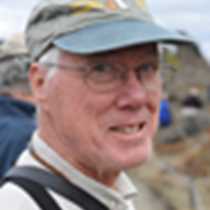Liefdefjord, Northern Spitsbergen
Early this morning we reached the northernmost part of Spitsbergen, the largest island of the Svalbard Archipelago. Shallow water kept out ship well offshore. We strained our eyes searching for wildlife on the snowy shore, looking for a rock or snow clump that would get up and move. Only by looking can you see. We turned south to enter Woodfjord, one of the many deep indentations on this glacier-carved coast, and then Liefdefjord, which enters Woodfjord from the west. We paused to watch a bearded seal resting on floating sea ice, a fragment of the frozen sea of last winter. That was good, but not quite at the top of our list of desired encounters. Near the Andøyene (Duck) Islands we spotted the white backs of beluga whales rising briefly to the surface. The group was spread widely over the water in front of us. Again ... exciting and seldom seen, but still not quite what we were seeking. We scanned every bit of shore-fast sea ice, looking for motion, anything to set it apart from its surroundings. Finally (how did they spot that?!), the call came out. Way off in the distance in front of Idabreen Glacier was a cream-colored spot, seen against the white of snow and ice. It was a polar bear, sitting immobile on the ice. The Captain pushed our ship through the soft ice until we were forced to stop, and still the bear was far off, still sitting motionless. It was not resting or loafing; not at all. Our distant bear had settled down to wait next to a seal breathing hole through the ice. It might take hours of attentive waiting until the seal made its appearance in the hole. Then, in a sudden burst of pent up energy, the bear would pounce, and hopefully (for the bear, but not for the seal) the seal would become our bear's next meal. It is a fascinating piece of polar bear biology but, in truth, it is not the most exciting to watch.
We moved on, leaving our bear waiting by that hole. Several glaciers (including Idabreen) enter Liefdefjord. The largest of these is Monacobreen, named to honor the contribution of Albert I Grimaldi, Prince of Monaco, to oceanographic research around Svalbard in the late 19th and early 20th centuries. His charting of the position of glacier faces gives us a baseline against which to compare more recent records in our warming world. We boarded our Zodiacs to cruise up to the fast ice that remains in front of the glacier face. Migratory birds are returning to take advantage of the short Arctic summer. We saw pairs of common eiders, the males conspicuous in black and white, the females a duller brown, the better to escape the attention of predatory birds that would gladly eat their eggs. Arctic terns, recently returned from their winter in Antarctic waters and brilliant in fresh new plumage and red bills and feet, gathered at their intended breeding colonies and engaged in a synchronized pas de deux mating flight of incredible grace.
We returned to the ship and relocated back to Idabreen. There he was (or maybe it was she), still sitting by that seal hole, occasionally lifting his/her head for a look around, and once rising for a brief stretch and stroll. The bear outlasted us. When we departed at 9:00 for further adventures tomorrow, the bear was still sitting by that hole waiting for the seal to appear. We will never know the outcome.




